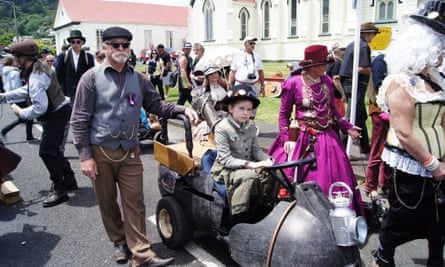The humble farming town of Oamaru, three hours south of Christchurch on New Zealand’s South Island, used to be known for its population of blue penguins and having the best-preserved collection of Victorian architecture in the country.
But that was before it became the world’s unlikely capital of steampunk, drawing enthusiasts from around to globe to what was once an economically depressed rural service centre wedged between the Kakanui mountain range and the Pacific Ocean.
Earlier this month Oamaru made it into the Guinness Book of World Records for the largest gathering of steampunks in the world.
For the uninitiated, the term steampunk was coined in the 1980s and is based on imagining inventions the Victorians might have created for the modern world. The movement was kickstarted by science fiction novels and has branched out to incorporate art and fashion while spawning a well-established aesthetic, typified by embellished hats and goggles.
Iain Clark, who is widely credited with launching steampunk in Oamaru and likes to be known by the name Agent Darling, said the movement began to take hold in 2010. At the time many locals were suspicious of what they saw as a weird niche interest gaining traction in their otherwise ordinary town.

But despite the early resistance, the movement grew.
“Some people can’t stand it, but most have come to accept that steampunk has allowed many shy people with slightly unusual interests to come out of the shadows,” said Clark.
“It has been particularly freeing for the creatives and artists in the community, to have Oamaru adopt something like steampunk as a core part of their identity.”
In 2010 Clark approached Weta Workshop – the Wellington-based special effects and props company that worked on Lord of The Rings — which donated half a shipping container of artwork and statues for a steampunk exhibition in the town.

The tipping point came when local farmers started turning up in droves to the exhibition, intrigued by the creative, outlandish inventions on display – which often incorporated materials scavenged from dumps and secondhand shops in the area.
“The farmers went home and started tinkering in their sheds, creating steampunk inventions. That’s when it really started to go like wildfire,” recalls Clark.
With the farmers on board, the wider community began to embrace steampunk too, and now it is not uncommon to see people sauntering down the main street in full Victorian costume, nodding politely at gob-smacked tourists.

“It seemed to hit a frequency at the right time,” said Helen Jensen, whose steampunk name is La Falconesse.
“New Zealanders are great creators and inventors, especially if they can make inventions from the junk collected in their garden sheds. I think the inventive side of steampunk is something Kiwis are particularly open to – making things from nothing makes sense to them.”
Oamaru is home to 14,000 people, many employed in the rich agricultural industry in the surrounding Waitaki district.
Driving along the town’s main drag you’ll pass the usual franchises – McDonald’s, KFC and Liquor Land. But turn towards the seaside and you’ll soon find yourself immersed in a steampunk wonderland, with pristine Victorian architecture carved from local stone, a steampunk-themed children’s playground and the looming, apocalyptic looking Steampunk HQ, a museum, stationed by the railway tracks.
“I didn’t understand what it was at first, and to be honest I probably still don’t,” said Kristen Murdoch, a local who works at the information centre.
“But I think Oamaru has gradually become accepting of it. It is so different and unique, it can be divisive, but it has definitely made us more open-minded, and it has been huge for young kids who might not be into the mainstream – it makes them feel more at home here.”
Steampunk games such as teapot racing invented in Oamaru have been adopted by steampunk groups the world over, and Clark knows a number of Victorian enthusiasts who have moved to Oamaru specifically to be closer to the thriving scene.
“It’s hard to feel shy when there are so many people walking around, bowing to you in the street,” said Clark.
“Being different is becoming the norm here – something we celebrate.”
Comments (…)
Sign in or create your Guardian account to join the discussion